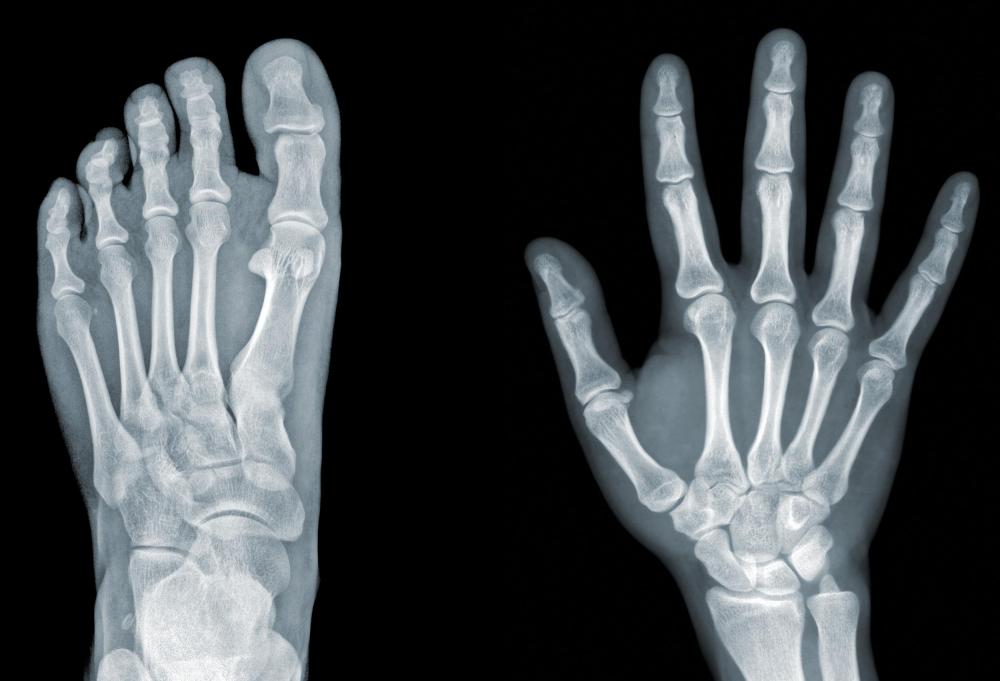At WiseGEEK, we're committed to delivering accurate, trustworthy information. Our expert-authored content is rigorously fact-checked and sourced from credible authorities. Discover how we uphold the highest standards in providing you with reliable knowledge.
What Is the Difference between a Radiologist, X-Ray Technician, and X-Ray Technologist?
A radiologist, X-ray technician, and X-ray technologist all work in the same field — radiology. However, they all have different roles to play in providing services to patients, and may work in different settings. It may also be possible for someone who starts his or her career as a X-ray technician to become X-ray technologist or a radiologist, but the training for a radiologist, X-ray technician, and X-ray technologist always varies.
X-ray technicians are trained in using X-ray equipment to take pictures of the inside of a person's body. These pictures are used in diagnosing diseases and injuries. Typically, X-ray technicians receive one to two years of training at a trade school, where they learn how to operate different types of X-ray equipment as well as how to position patients for efficient imaging.

X-ray technicians may find employment in hospitals and doctors' offices as well as in radiology clinics. They may also find jobs in nursing homes and dentistry facilities. In some cases, X-ray technicians venture into using other imaging technology besides X-rays, performing MRIs, CAT scans, and even ultrasounds. Though some people refer to those that repair X-ray equipment as X-ray technicians, they are more properly terms "X-ray repair technicians."

An X-ray technician cannot talk to patients about the results of X-rays or issue diagnoses. Instead, a radiologist or doctor typically has this responsibility. A radiologist is a person who is trained in interpreting diagnostic images, such as those obtained from X-rays as well as MRIs, CAT scans, and ultrasounds. Sometimes, a radiologist will also handle radioactive materials in the course of her medical-imaging work. A radiologist can also find work in a hospital, clinic, doctor's office, radiology center, dentist's office, or nursing home.

The difference between an X-ray technician and a radiologist is that an X-ray technician can only perform the X-rays while the radiologist gets the images from the technician and analyzes them, making a diagnosis. Sometimes radiologists also operate imaging equipment, such as when they work in a small facility that does not also employ a technician. Additionally, radiologists may perform some minor medical procedures that incorporate the use of imaging machines.

An X-ray technologist, also known as a radiographer, has typically completed at least two years of intensive training, culminating in an associate's or bachelor's degree. X-ray technologists use X-rays and other diagnostic-imagining tests to take images of a person's insides. Once these images have been taken and developed, an X-ray technologist passes them on to a radiologist who will diagnose the patient. Often, X-ray technologists are able to fill supervisory jobs and even interpret data in addition to operating imaging machinery.
AS FEATURED ON:
AS FEATURED ON:














Discussion Comments
Some states allow what we call "basic techs". These are technicians and have absolute minimal education. You can read a little booklet, take the test and be a basic tech without ever having positioned a patient, ever! Basic techs do not have the education and know next to nothing about radiation and its effects on the body.
Technologists have had two years of intense education and clinical training. They have passed a national Registry certifying them as Registered Technologists in Radiography RT(R).
I have been told by multiple MRT's and Radiologists not to refer to an MRT as an X-Ray Technician as it is viewed as demeaning (not to say an X-Ray technician is less deserving of respect, but it would be akin to calling a doctor a nurse or a nurse a janitor -- all respectable professions but quite different levels of training).
It is true that in some places, for example, the USA, the training they receive is quite limited.
However in Canada and the UK, for example, training is much more in depth and the job involves more than simply pressing a button.
The job involves (to name a few things): Prepping the patient for the procedure (example: administering the contrast agent, normally through IV or orally, though sometimes it goes in other holes as you should know); getting a drug history, etc.
Monitoring for any adverse reactions to the contrast, etc. Performing the actual procedure and acquiring the images. Making any necessary notes about the image etc (artifacts, issues, anything the patient didn't initially tell the physician, etc.)
Ensuring patient is not exposed to unnecessary dose and avoiding exposing a fetus, etc.
Controlling the technical factors (different people, conditions, body parts etc require different KVP and MAS settings on the machine to avoid overexposing the patient and to achieve a diagnostic quality X-ray).
While direct interaction between MRT and Radiologist is often limited in general X-Ray (excluding stress views) the two often work together for fluoroscopy. In some parts of the UK they even assist with the diagnosis. There are more parts to the job, but that covers a few of the obvious ones.
To clarify "In some cases, x-ray technicians venture into using other imaging technology besides x-rays, performing MRIs, CAT scans, and even ultrasounds," an MRT is qualified to perform a CT (cat scan) but must go through additional schooling to be qualified to perform an MRI or ultrasound.
An excellent source of information. Concrete information made this site more interesting.
According to the Bureau of Labor and Statistics, they both take x-rays.
Post your comments